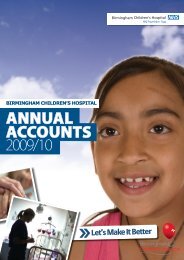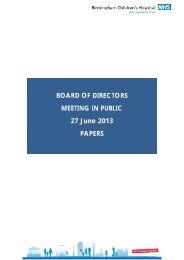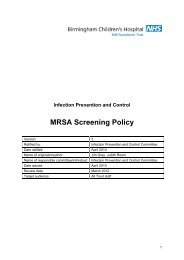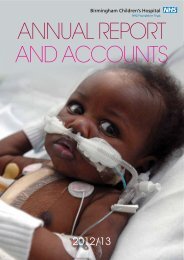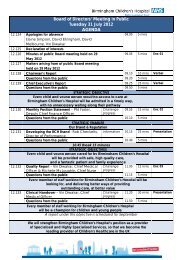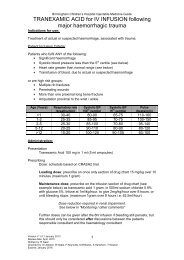Sixty years of the NHS - Birmingham Children's Hospital
Sixty years of the NHS - Birmingham Children's Hospital
Sixty years of the NHS - Birmingham Children's Hospital
You also want an ePaper? Increase the reach of your titles
YUMPU automatically turns print PDFs into web optimized ePapers that Google loves.
A haven for children:<br />
a typical ‘Nightingale’ ward<br />
at <strong>the</strong> Children’s <strong>Hospital</strong>,<br />
prior to <strong>the</strong> changes<br />
heralded by <strong>the</strong> <strong>NHS</strong>.<br />
As a ‘Charity <strong>Hospital</strong>’,<br />
it soon commanded <strong>the</strong><br />
affections and loyalty <strong>of</strong><br />
<strong>the</strong> people <strong>of</strong> <strong>Birmingham</strong>,<br />
relying entirely on charitable<br />
funding – yet <strong>of</strong>fering<br />
children free, specialised<br />
treatment.<br />
Thomas Heslop (1823-1885),<br />
physician and reformer, and <strong>the</strong><br />
<strong>Hospital</strong>’s founder in 1862.<br />
The current site<br />
has a building named in his<br />
honour, Heslop House.<br />
1948: The <strong>NHS</strong><br />
The <strong>NHS</strong> owes its very existence to <strong>the</strong><br />
way people feel about <strong>the</strong>ir children.<br />
When it was first proposed, <strong>the</strong>re was<br />
a view that <strong>the</strong> National Health<br />
Service would rob <strong>the</strong> existing Charity<br />
<strong>Hospital</strong>s – like <strong>Birmingham</strong> <strong>Children's</strong><br />
<strong>Hospital</strong> as it <strong>the</strong>n was – <strong>of</strong> <strong>the</strong>ir fiercely<br />
held independence. Opposition was<br />
real, and powerful. The greatest lever<br />
in overcoming it was <strong>the</strong> promise <strong>of</strong><br />
free healthcare for children. When<br />
people realised that <strong>the</strong>ir children's<br />
health would be improved, <strong>the</strong> battle<br />
for hearts and minds was won.<br />
And <strong>the</strong> promise was not a hollow<br />
one. The coming <strong>of</strong> <strong>the</strong> <strong>NHS</strong> in 1948<br />
did see massive improvements in child<br />
health. It gave children's hospitals, like<br />
<strong>Birmingham</strong>'s, <strong>the</strong> chance to develop<br />
from <strong>the</strong> local havens <strong>of</strong> excellence<br />
<strong>the</strong>y already were into <strong>the</strong> unrivalled<br />
specialists in paediatric provision <strong>the</strong>y<br />
have now become.<br />
Over <strong>the</strong> past 60 <strong>years</strong>, this <strong>Hospital</strong><br />
has undergone many changes,<br />
including a move back to its original<br />
site in Steelhouse Lane 10 <strong>years</strong> ago. It<br />
has become a national leader in some<br />
respects, internationally acclaimed.<br />
But at its heart lies <strong>Birmingham</strong>, in<br />
whose heart it commands a special<br />
place. As <strong>the</strong>se pictures show, 'The<br />
<strong>Children's</strong>' was both a pioneer and a<br />
place for people to hope.<br />
This commemorative souvenir booklet,<br />
issued to all <strong>Hospital</strong> staff, ends as it<br />
should: with a look into <strong>the</strong> future.<br />
Because that future is grounded in <strong>the</strong><br />
proud past, which is as much a cause<br />
for celebration as it is a reassurance <strong>of</strong><br />
who we are.
Politically incorrect?<br />
A patient makes <strong>the</strong>ir point to Princess<br />
Margaretha <strong>of</strong> Sweden, visiting <strong>the</strong> <strong>Hospital</strong> in<br />
December 1967. Many dignitaries and VIPs<br />
have graced <strong>Birmingham</strong> Children’s <strong>Hospital</strong><br />
throughout its history, including several<br />
monarchs.<br />
Pioneering Lab work.<br />
Sheila was diagnosed with PKU, a<br />
<strong>the</strong>n crippling inherited disease,<br />
in 1951 (right image). The labs at<br />
<strong>the</strong> <strong>Hospital</strong> pioneered her<br />
treatment with a special diet and<br />
she improved remarkably (left)<br />
– proving that diet alone could<br />
spare children from <strong>the</strong> disease.<br />
Sheila’s success is one <strong>of</strong> many<br />
that have marked <strong>the</strong> <strong>Hospital</strong>’s<br />
progress within <strong>the</strong> <strong>NHS</strong>.<br />
The move to a purpose-built site at Ladywood in<br />
1914 saw <strong>the</strong> Children’s <strong>Hospital</strong> start its <strong>NHS</strong><br />
history in a building still fondly remembered by<br />
many (now an entertainment complex, Broadway<br />
Plaza). The <strong>Hospital</strong> moved from here to<br />
Steelhouse Lane in 1998.<br />
Christmas on <strong>the</strong> wards, circa 1960.<br />
Parents were only allowed on Wards for restricted times well into <strong>the</strong><br />
1970s, when ideas about including families in child healthcare started<br />
to gain acceptance. Today, access is completely open and actively<br />
supported.
Staff see <strong>the</strong> past, hear <strong>the</strong><br />
history and glimpse <strong>the</strong> future<br />
In a series <strong>of</strong> talks, displays and<br />
presentations in July 2008, <strong>the</strong> very<br />
best <strong>of</strong> The Children’s <strong>Hospital</strong> from<br />
<strong>the</strong> past and <strong>the</strong> brightest hopes for<br />
<strong>the</strong> future were shown to staff and<br />
visitors to mark 60 Years <strong>of</strong> <strong>the</strong> <strong>NHS</strong><br />
– and 10 <strong>years</strong> <strong>of</strong> <strong>the</strong> <strong>Hospital</strong> moving<br />
to Steelhouse Lane. The displays were<br />
impressive. They ranged from <strong>the</strong> Eye<br />
Department’s past equipment,<br />
complete with ‘hands-on’ appliances<br />
staff enjoyed trying, to Clinical<br />
Photography’s working demonstration<br />
<strong>of</strong> <strong>the</strong> latest 3D imaging and The<br />
The displays were visited by many members League <strong>of</strong> Friends’ material showing<br />
<strong>of</strong> <strong>the</strong> public and patients as well as staff. <strong>the</strong>ir long association with <strong>the</strong><br />
<strong>Hospital</strong>.<br />
A time to celebrate<br />
Past <strong>NHS</strong> uniforms were on view,<br />
prompting memories for some <strong>of</strong><br />
Ward shifts in more orthodox times.<br />
Several <strong>of</strong> <strong>the</strong> displays boasted<br />
‘period’ instruments, some in wooden<br />
cases. The literature on display included<br />
pamphlets ‘for <strong>the</strong> public’, yellowed and<br />
lea<strong>the</strong>r-bound clinical texts showing<br />
just how much medicine has changed<br />
even in three generations, and many<br />
posters spanning <strong>the</strong> 60 <strong>years</strong>. A<br />
special visit <strong>of</strong> a 1960s ambulance,<br />
crammed full <strong>of</strong> original equipment,<br />
brought back many more memories.<br />
Staff and visitors also heard<br />
presentations to mark <strong>the</strong> occasion.<br />
Kate Parkes, from Radiology, began<br />
<strong>the</strong>se with an outline <strong>of</strong> how <strong>the</strong><br />
technology was <strong>the</strong>n and has<br />
developed since.<br />
Pete Hassan, Estates Manager, looks<br />
at archive material from <strong>the</strong> West<br />
Midlands Ambulance Service.<br />
Members <strong>of</strong> <strong>the</strong> Play Department, demonstrating a<br />
well–known play technique! Several Departments mounted<br />
<strong>the</strong>ir own ‘mini-exhibitions’ to celebrate.
The Liver Unit’s display, showing <strong>the</strong> typically<br />
comprehensive material on show.<br />
This Bedford ambulance was once a<br />
familiar site at <strong>the</strong> <strong>Hospital</strong>. Retired West Midlands<br />
Ambulance Service driver Malcolm Tomlinson, in<br />
1960s uniform, completes <strong>the</strong> picture.<br />
O<strong>the</strong>r presentations included<br />
Pr<strong>of</strong>essor Jill Mann’s Grand Round,<br />
which gave a comprehensive picture<br />
<strong>of</strong> <strong>the</strong> first ever UK Children’s Cancer<br />
Study Group and setting up <strong>of</strong> <strong>the</strong><br />
Cancer Registry. Pr<strong>of</strong>essor Deirdre<br />
Kelly’s talk on ‘Saving Livers, Saving<br />
Lives’ delivered <strong>the</strong> vivid story <strong>of</strong> <strong>the</strong><br />
Liver Unit and how this world-class<br />
service arose and grew. Linda<br />
Jenkinson’s presentation on <strong>the</strong> work<br />
<strong>of</strong> <strong>the</strong> Clinical Chemistry labs<br />
described <strong>the</strong> service’s history and<br />
achievements through to <strong>the</strong> present<br />
day (almost a million samples<br />
processed last year alone).<br />
The overriding impression was one <strong>of</strong><br />
pride and surprise. People loved<br />
seeing what o<strong>the</strong>r departments did<br />
and <strong>the</strong>y were impressed with <strong>the</strong><br />
breadth <strong>of</strong> skills that <strong>the</strong> <strong>Hospital</strong><br />
boasts.<br />
The Eye Department’s<br />
display allowed people<br />
to experience ‘vision-bending’<br />
goggles.<br />
A special ‘1940s’ <strong>the</strong>me<br />
was used to give a party<br />
atmosphere, albeit with<br />
some poetic licence, with<br />
Glen Miller tracks, tea<br />
and cakes for staff.
The Children’s <strong>Hospital</strong> has never<br />
been short <strong>of</strong> ideas or dreams. Its very<br />
foundation, almost 150 <strong>years</strong> ago,<br />
stemmed from a determination to<br />
give <strong>the</strong> children <strong>of</strong> <strong>Birmingham</strong> <strong>the</strong><br />
very best in specialised care.<br />
The new Teenage Cancer Trust (TCT) extension, to<br />
be built over <strong>the</strong> existing Emergency Department<br />
entrance with <strong>the</strong> support <strong>of</strong> <strong>the</strong> TCT, will greatly<br />
improve provision for teenage patients with cancer.<br />
The next 60 <strong>years</strong> hold at least as much<br />
promise. Much <strong>of</strong> this relying on<br />
public fundraising. This year (2008)<br />
saw <strong>the</strong> opening <strong>of</strong> <strong>the</strong> Burn,<br />
Neonatal Surgery and Education<br />
Centre, confirmation <strong>of</strong> <strong>the</strong> <strong>Hospital</strong>’s<br />
status as a major provider for burns<br />
treatment in children. In <strong>the</strong> next<br />
phase <strong>of</strong> development, <strong>the</strong> Renal Unit<br />
will be moved into that new building.<br />
Artist’s impression <strong>of</strong> <strong>the</strong> Wellcome<br />
Clinical Research Facility, which<br />
opened in August 2008. The facility<br />
focuses on ‘inclusive research’, where<br />
children and families are encouraged<br />
to participate in <strong>the</strong> research instead<br />
<strong>of</strong> being passive subjects.<br />
The vision continues<br />
A purpose-built research centre (<strong>the</strong><br />
Wellcome Clinical Research Facility)<br />
became operational this Summer; and<br />
work will soon begin on a new<br />
accommodation block for parents: all<br />
<strong>of</strong> <strong>the</strong>se part <strong>of</strong> an ambitious £150<br />
million redevelopment <strong>of</strong> <strong>the</strong> main<br />
hospital site on Steelhouse Lane.<br />
The new Burn, Neonatal Surgery and Education Centre, The<br />
‘Kidney Kids’ Appeal aims to fund <strong>the</strong> move <strong>of</strong> <strong>the</strong> Renal Unit<br />
into <strong>the</strong> last unoccupied floor, where <strong>the</strong> 60 Year Exhibition<br />
was held, as <strong>the</strong> next phase <strong>of</strong> development.<br />
This major redevelopment will include<br />
a new Ambulatory Care Centre, a new<br />
Emergency Department and Oncology<br />
Centre, a new Education Centre, and<br />
a new main entrance. The aerial photo<br />
<strong>of</strong> <strong>the</strong> existing Steelhouse Lane site<br />
shows how <strong>the</strong>se plans should be<br />
realised.
This devoted play area for patients with <strong>the</strong> Child<br />
and Adolescent Mental Health Services (CAMHS)<br />
will give some <strong>of</strong> <strong>the</strong> <strong>Hospital</strong>’s most vulnerable<br />
patients <strong>the</strong> chance to play in a protected space.<br />
It utilises part <strong>of</strong> Matron’s Garden within <strong>the</strong><br />
main <strong>Hospital</strong> grounds, which in <strong>the</strong> past would<br />
have been given over to patient exercise but<br />
which had fallen into disuse.<br />
The current main <strong>Hospital</strong> site on Steelhouse Lane,<br />
labelled to show how planned redevelopment will<br />
mean sweeping changes in <strong>the</strong> way <strong>the</strong> different<br />
areas are used, and in <strong>the</strong> services <strong>the</strong>y will <strong>of</strong>fer.<br />
The plans extend to fur<strong>the</strong>r<br />
redevelopment <strong>of</strong> <strong>the</strong> site, replacing<br />
<strong>the</strong> Dental <strong>Hospital</strong>, as part <strong>of</strong> <strong>the</strong><br />
concept <strong>of</strong> a ‘Children’s Health<br />
Quarter’ for children and young<br />
people in <strong>the</strong> city centre for future<br />
generations. <strong>Birmingham</strong> now has <strong>the</strong><br />
youngest population for a European<br />
city. Its diversity has always been its<br />
strength: from <strong>the</strong> ‘city <strong>of</strong> a thousand<br />
trades’ in <strong>the</strong> heyday <strong>of</strong> <strong>the</strong> Industrial<br />
Revolution, when <strong>the</strong> <strong>Hospital</strong> was<br />
founded, to <strong>the</strong> multi-ethnic population<br />
it now boasts. The <strong>Hospital</strong> draws on,<br />
celebrates, and contributes to that<br />
strength; and it will continue to grow<br />
with <strong>the</strong> <strong>NHS</strong> and <strong>the</strong> City in this, its<br />
third century.<br />
Whatever <strong>the</strong> future <strong>of</strong> <strong>the</strong> <strong>NHS</strong> holds,<br />
<strong>Birmingham</strong> Children’s <strong>Hospital</strong> will continue<br />
to care for children and young people – and be<br />
remembered as <strong>the</strong> special place it is.
Staff, patients and visitors were invited to leave messages saying what <strong>the</strong> <strong>Hospital</strong> meant to <strong>the</strong>m. These are some examples...<br />
© 2008 <strong>Birmingham</strong> Children’s <strong>Hospital</strong> <strong>NHS</strong> Foundation Trust




